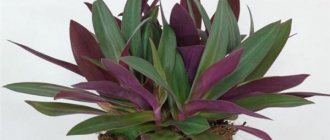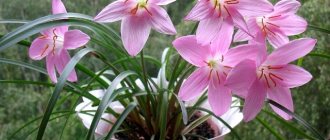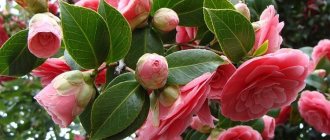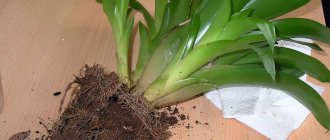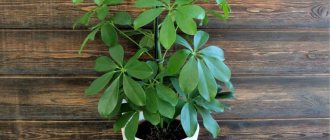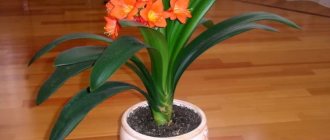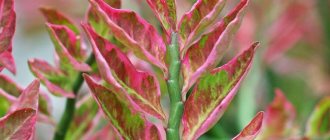Aechmea
Family: Bromeliads (Fam. Bromeliaceae)
In the period from mid-summer to early winter, in adult Aechmea plants, an inflorescence approximately 15 cm long appears from a leaf rosette - a funnel - with a bright pink color given by prickly scales. Flowering lasts about 6 weeks after which the inflorescence fades and dies. At the same time, two or three small rosettes appear, which can be planted as separate plants, or you can cut off the old rosette, giving freedom to the young ones.
This plant of the bromeliad family is native to Brazil; grows wild on trees; in decorative indoor floriculture it is grown as a ground crop. The Aechmea flower looks advantageous when simulating its usual living conditions - on a tree trunk.
Houseplant aeschynanthus and its main types with photographs
Aeschynanthus is a very rare exotic plant of the Gesneriev family.
Southeast Asia is considered its homeland, so the flower needs special conditions (high humidity and diffuse lighting). There are many varieties of aeschynanthus, but they all require compliance with certain rules of care. Inexperienced flower growers claim that growing an exotic flower at home is very difficult, and it is extremely difficult to achieve flowering. However, it's not all bad. If you know how to properly care for this plant, it will delight you with its flowering from June to October. The flower has several thin hanging stems, up to 70 cm long, covered with thick dark leaves (40 mm) arranged in pairs.
During the flowering period, beautiful dense clusters of several long flowers are formed at the tips of the stems. The color varies from yellow-orange to burgundy-red, depending on the variety. In the wild, Aeschynanthus is an epiphyte and grows on tree trunks. It has gained popularity in home floriculture due to its beautiful appearance and graceful flowering.
What it looks like, what family it belongs to
Aechmea is an epiphyte that belongs to the Bromeliad family and is the closest relative of the pineapple. The crop is considered a perennial plant with long, leathery leaves.
Aechmea is a beautiful ornamental plant
When grown at home, the flower does not exceed 30-90 cm in height. Its leaves reach 20-50 cm. They have small teeth on the edges. The leaves form a round funnel, in the center of which there is a rosette. On top they are covered with chaotically located stripes and spots.
Important! Aechmea is considered an epiphyte, so the purpose of its roots is considered to be anchoring on the trunk of another plant. The flower receives nutrition through the foliage.
Briefly about the history of appearance
The plant appeared in South America - in particular, in Mexico. In this region it grows by fixating on trees. The flower feeds on water and humus, which accumulates in the rosette.
Despite the region of growth, the culture has a Greek name. Its meaning is “tip of a pike”. It is interesting that the namesake of the exotic plant was the hero of a popular film - Prince Aechmea of the Land of Gems.
Varieties of Eschynanthus
There are more than 190 plant species, but only 15 are used in home floriculture. Let's look at the most popular varieties of aeschynanthus.
Mona Lisa
Less demanding to care for, therefore often used in home gardening. A beautiful plant with numerous stems. They are covered with small fleshy leaves, dark green in color with a bright longitudinal vein. At the very end of each stem, large, bright red-pink elongated flowers grow.
Lovely (beautiful)
Thin hanging stems up to 50 cm long with a woody base, on which dense, bright leaves are located. The leaflet is about 10 cm long and no more than 3 cm wide. The ends of the shoots are decorated with inflorescences of 6-8 tubular flowers, yellow at the base and red at the tips.
Marble
Its main difference is its unusual leaves, with light green streaks reminiscent of the structure of marble. The lower part of the leaves is dark brown in color, and they themselves reach 10 cm in length. In a hanging pot, the plant looks very elegant and beautiful, but its flowering is not impressive. Due to the bright foliage, the small greenish tubes of flowers are almost invisible.
Thai pink
A delicate, graceful and beautiful plant, with thin long shoots and small heart-shaped dark leaves. Quite a rare variety. Those who want to buy aeschynanthus Tai pink should keep in mind that this is a rather demanding and capricious plant variety. During the flowering period, large, light pink tubular inflorescences are formed on the stems, usually 4 pieces each.
Caroline
An interesting plant, with strong thick shoots and large oblong pubescent leaves. The length of the stems is about 50-60 cm, and at the tips there are several burgundy flowers. The variety is capricious, requiring special conditions.
Rocky
A unique species of aeschynanthus that does not require soil, because in the wild it grows well on moss-covered rocks and in the mountains. It is practically not used in home floriculture.
Twister
A beautiful and unusual plant, with long curved stems and curly small leaves. They are glossy, curved inward, and dark, rich in color. The flowers are dark orange and red, growing both at the ends and in the middle of long shoots.
Firebird
The variety is popular among gardeners due to its colorful, bright flowers. There are many artificially bred varieties of the variety, with large purple, pink or multi-colored flowers. At the same time, the stems and leaves of the plant are usual for aeschynanthus.
Rasta
In the shape of the stems and leaves, Rasta is very similar to Twister. Its shoots also tend to curl, and the curly leaves are rich green in color and small in size. The only difference is the color of the tubular inflorescences. Rasta's is dark red.
Bella Donna
The variety is more compact, with small rounded shiny leaves. The shoots are long, and the flowers are medium-sized, red in color, 4-6 pieces per inflorescence.
Rigel
A plant with large long leaves, thin stems and large orange flowers. Less demanding of care than other varieties, but prefers a warm room with diffused light.
Those who want to purchase this exotic plant need to study the conditions for keeping and caring for eschynanthus.
Caring for and growing Eschynanthus at home
It is important to remember that aeschynanthus is a tropical plant that requires high humidity and light. It is impossible to completely create the necessary conditions in the room, but there are several points that are worth paying attention to.
Lighting
Eschinanthus does not tolerate direct sun and can die from burns. Diffused, dim light would be ideal for it, and it is better to place the pot in the western or eastern part of the room. If the choice fell on a south window, then the plant must be artificially shaded, especially at noon. On the northern window, due to lack of lighting, the aeschynanthus will not bloom.
Air humidity
It requires high humidity, so you will have to place a humidifier or just a cup of water nearby. Additionally, the container with the flower is placed on a tray with well-moistened moss. In summer, it is necessary to regularly spray the plant with a spray bottle, avoiding water getting on the flowers. At the same time, the water should be at comfortable room temperature, filtered, but not boiled.
Watering
Despite the requirements for air humidity, aeschynanthus does not tolerate excessive watering. It should be watered only when the top layer of soil has dried by 3-5 cm. In summer it is watered on average 1-2 times a week, and in winter - much less often. Too infrequent and irregular watering can lead to the cessation of flowering, shedding of leaves and death of the plant.
Overwatering is no less dangerous than drought, because it leads to rotting of the root system.
Fertilizer
Fertilizing is carried out in summer and spring, using universal fertilizers for indoor plants. Before use, you must carefully read the instructions and halve the dosage required for ordinary plants. Fertilize once a week, along with watering, but only during the flowering period.
Trimming
Pruning will help improve the appearance of the plant. It is carried out after flowering, removing 1/3 of the long stems. In addition, it is necessary to remove old dry leaves and pinch the tops of the shoots. Some gardeners recommend pruning aeschynanthus before flowering, but there is not much difference.
Transfer
Separately, it is worth mentioning the transplantation, which is carried out after purchasing a flower. In the future, the plant is replanted annually, in the spring, before flowering.
First you need to prepare the pot, soil and drainage. Several holes are made at the bottom of the pot and a layer of expanded clay is laid. Eschynanthus does not like spacious containers, and each subsequent pot should be only 20 mm wider than the previous one. It is better to choose a wide but shallow container, and transplantation is carried out using the method of careful transshipment.
Find comprehensive information about the Koleriya flower and how to care for it at home at this address: https://cvetolubam.ru/koleriya/
This material will be useful to those who plan to have an aquarium crinum at home.
What medicinal properties does Murraya contain and what benefits or harm does it bring to its owner is written here.
Aechmea sparkling
This plant does not like greedy and boastful people. It tries to neutralize and dispel such bad energy that disrupts sleep, excites the nervous system, and reduces performance. It is better not to place the echmea in the bedroom; it is better to place it on the desktop in the office. The long presence of echmea in an apartment helps to increase the iron content in people's blood, a person wakes up easily, drowsiness disappears, improves muscle condition and helps maintain physical tone.
Similar plants:
- Room Guzmania
- How to grow pineapple at home
Methods for propagating Eschynanthus
Like all living things, aeschynanthus ages and requires renewal. Not only pruning and replanting will help with this, but also propagation. After 5 years, the flower loses its decorative effect, so it is better to grow a new plant.
The simplest method is propagation by stem cuttings , about 10 cm long, with several ovary nodules. The cuttings are cut immediately after flowering, the lower leaves are torn off and placed in a small glass of water. You can germinate them in a moist soil mixture of sand and peat.
Before planting, the cuttings are treated with Kornevin's solution, placed in prepared soil and covered with film. The cover is removed daily for 2-3 hours to ventilate. The container with the seedlings is placed in a warm place, at a temperature of +25C, and after a couple of weeks they will take root well. After which, they can be planted in separate pots.
Reproduction by leaf blades is approximately the same. Select a leaf with a bud, treat the cut site with potassium permanganate, coal and place it in water or a nutrient substrate (peat + sand).
When the plate takes root, it is moved to a separate container. Drainage is placed at the bottom of the pot, and soil from turf soil, peat and river sand is placed on top.
Growing aeschynanthus from seeds is not at all easy, but it is possible. After flowering, small boxes with small seeds form on the plant. They are carefully removed, poured into the soil mixture for germination and covered with glass.
Often, when breeding aeschynanthus with seeds, a simple mistake is made. The fact is that you cannot water the plantings, but moisten the soil simply by pouring water into a tray on which there is a container with seeds. When the seedlings grow a little and become stronger, they are transplanted into small pots. Such plants will begin to bloom within a year.
How does it reproduce
Since the rosette dies off after the inflorescences wither, breeders are forced to systematically propagate the crop. This is a fairly simple process, since the children settle down without any problems.
Propagation by cuttings
It will not be possible to cut the cuttings for propagation. It has a small stem that will not grow. Moreover, the plant will die immediately. Therefore, propagation of echmea is carried out by shoots. After the mother plant finishes flowering, the rosette produces babies and dies. The withering process is slow. During this period, children get stronger and grow.
It is necessary to separate the daughter rosette from the common roots at the moment when it reaches 2/3 of the height of the mother culture. To propagate a flower you need to do the following:
- Remove the plant from the pot and remove the soil.
- Make a cut that minimally damages the roots of the baby.
- Sprinkle the affected area with coal or chalk.
- Fill a pot with a diameter of 10 cm with nutrient substrate.
- Place the baby and cover it with a jar or bag. It is important to ventilate the plant every day.
- It is necessary to constantly maintain soil moisture and protect the echmea from direct sunlight.
- After 20 days, it is worth checking the growth of roots.
- If they have begun their development, the pot should be placed in a new place and the culture should be properly cared for.
When the bush grows, it will need to be replanted. If several children were planted, they need to be seated.
Reproduction by layering
Aechmea is not propagated in this way. The stem of the crop does not bend and does not form aerial roots. It is best to propagate the plant from offspring.
Aechmea is propagated by offspring
Difficulties and problems in care
Often, novice gardeners who buy exotic aeschynanthus for the first time encounter problems. Suddenly the leaves begin to fall, the shoots turn yellow and dry, and flowering stops. If leaves begin to fall in winter, the low temperature may be to blame. The fall of leaves in the summer requires compliance with the watering and moistening regime.
The cause of yellowing and drying of leaves is often dry air in the room. The appearance of brown or orange spots on the leaf blades can be caused by sunburn or watering with cold water. The shoots have become soft, loose and watery - this is due to excess moisture in the soil.
If a plant does not bloom for a long time , then it does not have enough sunlight. Often, the answer to the question of why aeschynanthus does not bloom lies in improper care, when the plant is not given the necessary rest period.
When flowering has begun, but the flowers fall off before they have time to bloom, the plant needs good watering and moisture. We must not forget about the mandatory regular fertilizer.
Aechmea flowering
In summer or late winter. Bright light promotes flowering. The flowers themselves are small; large pink bracts with spiky edges attract attention. Flowering can be stimulated by placing a plant with ripe apples in a transparent bag for one to two weeks; the apples emit ethylene gas, which promotes faster ripening of flowers. In 4 months the echmea will bloom.
Aechmea flowering
Diseases and pests affecting Eschynanthus
More often, aeschynanthus is attacked by aphids, mealybugs and scale insects. Aphids are clearly visible on the leaves and cause them to turn yellow and fall off. With a small number of pests, washing the leaves with a solution of laundry soap will help. When there are a lot of insects, you can prepare an infusion of ground black pepper (200 g) and half a liter of water. Mix everything, boil for an hour and leave for a day. The resulting solution is sprayed onto the affected leaves.
Mealybug appears as a white cottony coating on leaves and shoots. You can save the flower using the same laundry soap. As a last resort, treat it with a special preparation (Aktara).
A garlic infusion made from 1 tsp will help get rid of scale insects. grated garlic and half a liter of water. It is easy to recognize the appearance of insects by the brown tubercles on the leaves. If garlic is not effective, then you will have to use Aktara.
The most common diseases of Eschynanthus are gray rot and powdery mildew. The reason for the development of rot is waterlogging and drafts, and powdery mildew appears due to a combination of low temperature and high humidity in the room.
A single treatment with Fundazol, according to the instructions, will help get rid of gray rot. Powdery mildew is removed using a solution of potassium permanganate, and in severe cases, only by treating it with Topaz or Vectra.
This article talks about what care the pike tail plant needs at home.
Recommendations for those who notice that pachystachys leaves are curling are here.
The capricious aeschynanthus is increasingly winning the love of flower growers. Despite the fact that it is not easy to care for, the plant is popular for its unusual beauty and elegance.
Possible problems during cultivation
When breeding a crop, there is a risk of various problems arising. Most often they are caused by violation of the rules of plant care.
Why doesn't the flower bloom?
Reasons for lack of flowering:
- insufficient lighting;
- low level of humidity during the period of active development of the crop;
- temperature less than +18 degrees or more than +35;
- influence of direct sunlight;
- strong soil moisture - stagnation of water provokes the process of rotting of the root system.
To activate the flowering process, you can resort to the following measures:
- Place chopped apples or bananas in moist soil. As the fruits spoil, replace them with fresh ones.
- Provide the crop with greenhouse conditions. To do this, you can cover it with a glass jar or bag. It is important that the temperature in the greenhouse is at least +25 degrees.
- Systematically ventilate the plant and control soil moisture.
On average, resuscitation measures allow you to get a peduncle within 10 days.
Why do Aechmea leaves turn yellow, dry out and fall off?
Most often, the leaves of the crop turn yellow due to the development of fungal infections. When root rot appears, leaves turn yellow and die. During this period, the root system of the plant darkens and rots.
If the rules of care are not followed, the plant suffers from fungal infections.
Timely diagnosis helps prevent plant death. To do this, you need to pull it out of the ground, inspect the root system and cut off the affected fragments.
Then the plant should be transplanted into new soil and moved to a warm and well-lit place. In case of significant damage, you can cut off the top of young branches. This will help save the plant's energy.
Important! It is possible to moisten the soil only when the development of the crop has noticeably begun. The cause of fungal infections is considered to be overwatering.
Pests
Aechmea can suffer from various pests. These include mites, scale insects, and scale insects. To cope with parasites, treat with a soap solution. If this does not help, you must resort to the use of insecticides.
Other problems
Violation of the rules of plant care provokes the loss of decorative foliage and the development of diseases:
- The appearance of dryness on the surface of the leaves. This indicates insufficient air humidity.
- Wrinkling of leaves. This indicates a moisture deficiency. If they do not recover after watering, then there are problems with the root system.
- Yellowing of leaves and loss of variegation. Such signs indicate a lack of lighting.
- Damage to leaves and stems by rot. In this case, the roots of the plant cannot be saved. Such problems are associated with excess moisture and low temperature.
Violating the recommendations of gardeners provokes a change in leaf color
Caring for Eschynanthus at home
There are more than 190 species of Eschynanthus in the world. It grows in Asia, most often found in the southern and eastern parts. It grows on trees and is an epiphyte (it does not feed on another plant). An adult plant reaches 90 cm. Mostly gardeners grow magnificent aeschynanthus.
This is a perennial, evergreen, hanging plant. In addition, flower growers breed marbled aeschynanthus, which is characterized by a special color of leaves that have different shades of green up to brown.
Eschananthus "Lobba" has red flowers, and "Mona Lisa" is less whimsical compared to other species. "Twister" is distinguished by curly leaves and orange-red flowers.
In addition to these species, you can also find aeschynanthus “Carolina”, “Rasta”, “Belladonna”, tricolor, rocky, “Firebird”.
Growing all varieties of this plant requires compliance with a number of conditions. Next, let's look at which ones.
Temperature
The air temperature in the room where the flower is planted should be within +23 - +25*C. This condition must be observed in the summer.
For winter, it is important to reduce it to +16* - this will allow the plant to go into a dormant period and lay the buds of future flowers. Drafts, cold gusts of air, and frequent changes in temperature will also negatively affect the plant.
Eschynanthus loves a sufficient amount of light, but it is advisable to avoid direct rays. Because direct light significantly reduces the flowering period.
Florists recommend placing the flower on western and eastern windows. If this is not possible, and you have to use southern window sills, then you may need to provide a little shade. On the north side there is a risk of lack of light.
Pest protection
Aechmea is affected by aphids, scale insects, spider mites, and root scale insects. The first thing to do is isolate the infected flower. Washing the plant in the shower helps against a small number of pests. Another option is to wipe the leaves on both sides with a cotton pad soaked in an alcohol solution.
If there are a lot of insects, then chemicals are used. Spider mites can be controlled using the biological pesticide Fitoverm. To destroy scale insects, use the drugs Aktara or Insektor. Ditox is effective against root bugs.
Why does Eschynanthus shed its buds and leaves? What to do?
This question can be answered if you know at what period of the plant’s life this occurs. During the dormant period, that is, late autumn and winter, the plant can shed its crown due to a decrease in air temperature and a long period of established low values.
In the summer, when the plant blooms, the aeschynanthus most likely sheds its buds due to lack of moisture in the soil. In addition, when spraying a plant during the flowering period, you must be extremely careful, because drops of water falling on the buds will most likely cause them to fall off prematurely.
Eschynanthus: how to please a luxurious but whimsical handsome man
Few Russian lovers of indoor flowers are closely familiar with the plant named aeschynanthus. Until now, this Tropican is exotic for our apartments. Aeschynanthus has an attractive appearance: its long shoots are dressed in harsh, bright leaves, and the ends are decorated with scarlet flowers directed upwards. But this handsome man has a very capricious character, not everyone can please him. Although some flower growers are not afraid of the difficulties, they assure that aeschynanthus is quite amenable to education, you just need to find the right approach to it.
Origin, appearance and features of eschynanthus
The homeland of Aeschynanthus is the tropical forests of southeast Asia. In its natural environment, the plant lives in Thailand, Vietnam, Indonesia and Malaysia. This is an epiphytic bush, adapted to life off the ground, on snags, trees or stones. For this method of existence, Eschynanthus has long (about half a meter) creeping stems and thick leaves that are capable of storing moisture. This is convenient - it rains rarely, but plentifully in the tropics. In its native land, the plant is accustomed to warm, moist air and scattered but bright sun.
Echmea and Feng Shui
Echmea will be useful for indecisive and absent-minded people who have many plans and desires, but do not take action. A strong Mars plant develops independence. When you are alone, sparkling echmea will strengthen the soul and help you see the good sides.
aechmea plant
Aechmea is especially useful for men, because Mars, a masculine planet, strengthens the qualities in a person that are considered the property of a man. But Aechmea can make women rude, harsh and overly businesslike, especially if there are no other plants in the apartment besides Aechmea.
Conditions in nature and at home
Aeschynanthus is an inhabitant of the tropical forest. And at home, he is faithful to the habits acquired in nature. He still strives for the sun, prefers moist and warm air, without sudden changes in temperature. But it is ready to live the winter in a cool place and will be content with scanty watering. So, when creating a climate for aeschynanthus, take into account the natural conditions to which it is accustomed, and there will be no problems with growth and flowering.
Sources:
https://cvetolubam.ru/eshinantus/ https://room-plant.ru/komnatnye-rasteniya/ampelnye-rasteniya/eshinantus/uhod-v-domashnih-usloviyah-foto-2/ https://diz-cafe. com/rastenija/esxinantus-kak-ugodit-roskoshnomu-no-prixotlivomu-krasavcu.html
